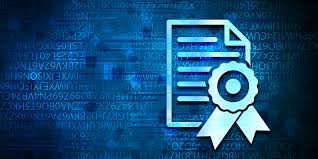Digital credentials in the education sector are really a new, innovative way to engage learners and develop further opportunities for students’ learning and careers. It is already clear, as 2025 sets in, that this adoption goes beyond a fad to rank as one of the most far-reaching changes in the history of education-institutionalized ways of verifying and showcasing the skills and achievement of students and learners. This blog discusses the transformation that digital credentials bring about in education and their potential for empowering learners and improving their employability prospects.
Digital credentials-what are they?
Digital badges are a virtual representation of learning achievements in forms of badges or other certificates, standing for verified competencies and qualifications. Therefore, it lets the learners express themselves in a much more secure yet accessible way. Contrary to the traditional paper-based certificates, digital credentials on the other hand will be verifiable instantly by employers and educational organizations at the time of hiring and admission. This decreases the complexities regarding manual verification, hence speeding up more informed decisions by organizations while wasting the least amount of time.
Enhancing Learning Experiences
1. Empowering Learners
Probably the biggest advantage is that, above all else, digital credentials just simply empower learners in education and their career by taking ownership. But at the very core of that is providing learners with a medium through which their competencies, or skills, are more effectively vocalized. The bottom line of importance lies in making themselves sound marketable to this newer generation of hiring managers. Digital badges using open standards -like Open Badges-contain metadata that not only ensures the badge is authentic but also outlines the skills achieved from a certain experience.
2. More Engagement
The schools that implement digital credential programs usually experience higher learner interaction. It is supported by the fact that 60% of learners are more likely to finish a course if they receive a digital badge for that course. Organizations like IBM have also reported that badge earners experience an average increase in engagement, with many returning to earn more badges. Such a recognition-skill development cycle keeps the learners motivated, thereby enriching the educational experience.
Bridging the Gap Between Education and Employment
1. Alignment with Industry Standards
Digital badges, or credentials, can be tailored to meet specific industry standards and competencies to adequately prepare students with the job market skills. Such alignment of curriculum will help improve graduates’ employability, while strengthening the tie between educational institution and industry leader partnerships. In collaboration with employers in developing industry-aligned learning experiences, schools can help ensure their graduates leave with the workforce skills needed today.
2. International Recognition and Mobility
With increased cross-border acceptance of digital credentials, they will also lead to increased mobility of workers and students across the globe in search of jobs or higher education. Such recognition provides an avenue for learners to demonstrate their skills on the international stage-to-innovate and advance the global workforce. This also ensures that more geographical barriers are broken, allowing various types of learners to validate their achievements.
Streamline Administrative Processes
1. Cost Efficiency
The transition to digital credentials can help educational institutions cut their costs drastically. It enables an institution to manage its resources effectively by reducing printing, mailing, and physical storage of certificates. Savings can be utilized in enhancing educational programs and student service. Secondly, streamlined management systems for credentials reduce administrative overheads while minimizing human error in documentation.
2. Improved Security and Verification
Digital credentials are more secure and credible than traditional paper certificates, which can easily get lost or forged. One-click verification means stakeholders can verify the credential in real-time, reducing verification time and adding to security measures. This level of security is crucial in a time when trust of qualifications is of essence.
Promoting Inclusivity
Digital credentials foster inclusivity by making education more accessible to all learners, regardless of their location or socioeconomic status. By adopting Digital solutions, institutions can promote equity in education, ensuring that every student has the opportunity to validate their skills and achievements. This inclusivity not only benefits individual learners but also enriches the educational ecosystem by diversifying perspectives.
Conclusion
The integration of digital credentials within educational systems marks a whole new era in how skills and achievements are recognized and authenticated. It helps increase the engagement of learners, embeds standards set by industries, streamlines administrative burdens, and engenders inclusivity for a more effective and transparent education sector.
As we go deeper into 2025 and beyond, educational institutions will have to move with this evolution in credentialing practices if they are to remain relevant in an increasingly competitive job market. This not only raises the bar for what they have to offer but also equips learners with what they need to succeed in their careers. The future of education embraces innovation, and at the forefront of this transformation are digital credentials.
Take the first step towards secure and reliable credential verification. Visit EveryCRED today and see how we can help you build trust in every interaction!
Also Read
- ► What Makes a Great Automation Products Supplier?
- ► Make Your Craft More Level Ideas with Waterslide decal paper Strategies
- ► North America Aviation Market: Trends, Growth, and Forecast 2025-2034
- ► PawBiotix™ | Official Website
- ► What are the key factors to consider for choosing scanner and desktop rental systems
- ► An Expect Guide to PTE Reorder Paragraph Task
- ► Natural Remedies for Depression: An Ayurvedic Approach
- ► NeuroQuiet™ | Official Website | Supports Hearing
- ► Eastern Suburbs: Sparkling Solar Panels & Spotless Gutters
- ► Your Ultimate Shopping Guide to Broken Planet Market
- ► Best Foods for Dinner in the USA
- ► INDIAN VISA FROM AUSTRIA
- ► Flydubai Sales Office in Lahore
- ► ProstaVive™ | Official Website | #1 Prostate Supplement
- ► ProstaVive Official Website





